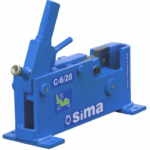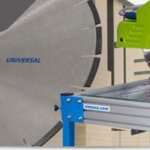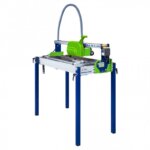When it comes to laying down new tile, whether as flooring, a bathroom wall or even a countertop, there’s nothing like a wet tile saw to get the job done quickly with professional looking results. A manual tile cutter is a fine tool for professionals or for small jobs, but they have their drawbacks. First, if you don’t know what you’re doing, it’s likely that you will waste a lot of tiles after breaking them the wrong way. And second, even when you do manage to break the tile correctly, the cut won’t be as clean as if you did it with a tile saw.
If you need to know how to use a tile cutter wet saw, you should know that it isn’t very complicated. That being said, this article will help you to decide which type of tool you should get for the job: a tile cutter or a wet saw.
Contents
Tile saw vs tile cutter: how to use them and for what
Using a manual tile cutter is tricky if you are a novice. The process involves lining the tile up so that a small blade runs along your desired cutting line. The user has to manually press and slide this blade into the tile in order to score it. Then, you have to carefully snap the tile along the score line to actually break it in two. This is why it requires some finesse and technique to do a good job.
A wet tile saw, however, is much more user-friendly in comparison. In many cases, you won’t even have to worry too much about setup because much of the work will be done for you in the case of a tile saw rental. Basically, this means that the wet saw will already have an appropriate diamond blade attached to it. All you will have to do is fill up the water tank and make sure the saw can be safely plugged into an outlet, if electrical, or that it is in a well-ventilated area if it has a petrol motor.
Before you start cutting, check for any obvious signs of wear or damage, and ensure that when the tile saw is powered on, water is pumped over the blade. This is what makes it a wet tile saw, and is very important for safety as well as the life of the blade and machine.
Obviously, you will need to measure and mark the tiles you need to cut before going any further. Once that is done, the rest of the process is fairly straightforward. Place the tile on the sliding table of the wet tile saw so that the blade lines up with where you want to cut. Power on the saw, check that water is flowing over the diamond blade, and slowly slide the table towards the blade. The diamond particles on the blade will grind their way through the tile, making a clean, professional looking cut.
Certain types of tile are prone to chipping at the end. If this happens, try applying gentle inward pressure to the sides of the tile as the blade works its way through the last inch or so.
So, tile cutter or wet saw?
According to the tips that we have offered through this article, now you must decide whether to use a tile cutter or a wet saw. We recommend that if you just need to cut some tiles, a tile cutter is all you need for the job. You may break some tiles, but it is just a matter of practice and patience. That is why a manual tile cutter is better known as “the best tool to have at home to cut some tiles”.
However, if you need the tool to cut tiles for professional projects, a wet saw is a better bet because you will end the cutting work faster, better and cheaper in terms of efficiency. But, of course, this is just our advice. It will be always up to you!





